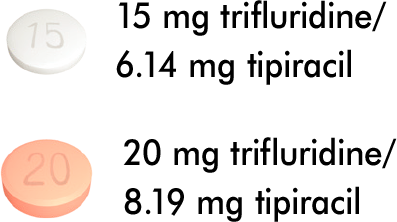LONSURF
Dosage Calculator
Calculate your patients' personalized dosage and create personalized dosing calendars.
Dosing Guidelines
Proper dosing is important for treatment results1
- Dose oral treatment twice daily, with food
- Calculate by body surface area (BSA)‑35mg/m2
Oral treatment starts with indicated dosinga,b
- Round BSA-based calculation up to the nearest 5-mg increment‑never exceeding 80 mg/dose or 160 mg/day
If needed
Dosing guidelines for LONSURF® (FTD/TPI) tablets
| Indicated dosage | 35 mg/m2 twice dailya,b |
| Active treatment days | Days 1 to 5 and 8 to 12 of each 28-day treatment cycle |
| BSA-based caculation |
|
| Administration |
|
| Missed or vomited doses | Instruct patients not to retake doses of LONSURF that have been vomited or missed, and to continue with the next scheduled dose |
| Handling | LONSURF is a cytotoxic drug. Follow applicable special handling and disposal procedures |
aBased on the trifluridine component
bIn patients with severe renal impairment (CLcr of 15 to 29 mL/min), the recommended dosage is 20 mg/m2.1
Two tablet strengths for personalized dosing1


Tablets shown are not actual size
Examples of proper dosing according to BSA
Proper dosing examples*
Patient with BSA of 1.31 m2 would take three 15-mg tablets per dose for a total daily dose of 90 mg:
Morning Dose =



Evening Dose =



15 mg trifluridine/6.14 mg tipiricil tablet
Patient with BSA of 1.72 m2 would take three 20-mg tablets per dose for a total daily dose of 120 mg:
Morning Dose =



Evening Dose =



20 mg trifluridine/8.19 mg tipiricil tablet
Tablets shown are not actual size. Actual tablet size is 7 mm for the 15-mg dose and 8 mm for the 20-mg dose.
*In patients with severe renal impairment (CLcr of 15 to 29 mL/min), the recommended dosage is 20 mg/m2.1
Dosage Cycle
LONSURF is dosed over a 4-week cycle (28 days)1
| Week 1 | Twice daily for 5 days with food | 2 days rest |
| Week 2 | Twice daily for 5 days with food | 2 days rest |
| Week 3 | Rest | |
| Week 4 | Rest | |
Obtain complete blood cell counts prior to and on day 15 of each cycle1
Dosage
Modifications
Importance of dose modification with LONSURF® tablets-FTD/TPI1

When to delay the dose1:
At treatment initiation, delay the cycle start of LONSURF until:
- Absolute neutrophil count (ANC) is ≥1500/mm3 or febrile neutropenia is resolved
- Platelet count ≥75,000/mm3
- Grade 3 or 4 non-hematological AEs are resolved to Grade 0 or 1
During treatment, withhold LONSURF for:
- ANC <500/mm3 or febrile neutropenia
- Platelet count <50,000/mm3
- Grade 3 or 4 non-hematological AEs

When to reduce the dose1:
After recovery, resume LONSURF after reducing the dose by 5 mg/m2/dose from the previous dose level for:
- Febrile neutropenia
- Uncomplicated Grade 4 neutropenia (which has recovered to ≥1500/mm3) or thrombocytopenia (which has recovered to ≥75,000/mm3) that results in more than 1-week delay in start of next cycle
- Non-hematologic Grade 3 or 4 AEs except for Grade 3 nausea and/or vomiting controlled by antiemetic therapy or Grade 3 diarrhea responsive to antidiarrheal medication
A maximum of 3 dose reductions are permitted to a minimum dose of 20 mg/m2 twice daily. Do not escalate LONSURF dose after it has been reduced.1
Permanently discontinue treatment with LONSURF if patient cannot tolerate reduced dose.
These are the only AEs that require a dose reduction.
In patients with severe renal impairment who are unable to tolerate a dose of 20 mg/m2 twice daily, reduce dose to 15 mg/m2 twice daily.
In the RECOURSE trial1,2:
- 14% of patients taking LONSURF required a dose reduction
- The most common adverse reactions or laboratory abnormalities leading to dose reduction were neutropenia, anemia, febrile neutropenia, fatigue, and diarrhea
- 53% of patients treated with LONSURF had a dose delay of ≥4 days due to an AE
In the TAGS trial1,3:
- 11% of patients required a dose reduction
- The most common adverse events or lab abnormalities leading to dose reduction were neutropenia, anemia, febrile neutropenia, and diarrhea
- 42% of patients treated with LONSURF had a dose delay of ≥4 days
Dosage
Calculator
Calculate your patients' recommended LONSURF starting dosage
Start new LONSURF patients with the recommended dosage using the Dosage Calculator below. To calculate a patient’s personalized dosage, follow these three steps:
NOTE: This tool is only intended for use in calculating patients’ starting dosage. For directions on appropriate dose modification for AE management at cycle start or during a cycle, click here. See Prescribing Information for recommended dosage in patients with severe renal impairment.
- Step 1: Choose Height and Weight to calculate your patient's BSA by entering his/her height and weight (in metric or imperial units), or BSA to enter his/her BSA (m2) directly.
Please enter a valid height
Please enter a valid weight
(rounded per PI)
Please enter a valid BSA (rounded to 2 decimal places)
- Select Dosage
- mg
- mg
Pill Count
Morning
Evening
*Tablet strength of LONSURF is based on the trifluridine component.
BSA = Body Surface Area
BSA calculated using the DuBois formula3
FTD/TPI = trifluridine/tipiracil
References: 1. LONSURF [Prescribing Information]. Princeton, NJ: Taiho Oncology, Inc.; 2019. 2. Mayer RJ, Van Cutsem E, Falcone A, et al; for the RECOURSE Study Group. Randomized trial of TAS-102 for refractory metastatic colorectal cancer. N Engl J Med. 2015; 372(20): 1909-1919. 3. Data on file. Taiho Oncology, Inc., Princeton, NJ.
INDICATIONS
INDICATIONS
LONSURF is indicated as a single agent or in combination with bevacizumab for the treatment of adult patients with metastatic colorectal cancer previously treated with fluoropyrimidine‑, oxaliplatin‑ and irinotecan‑based chemotherapy, an anti‑VEGF biological therapy, and if RAS wild‑type, an anti‑EGFR therapy.
LONSURF is indicated for the treatment of adult patients with metastatic gastric or gastroesophageal junction adenocarcinoma previously treated with at least two prior lines of chemotherapy that included a fluoropyrimidine, a platinum, either a taxane or irinotecan, and if appropriate,
INDICATIONS
LONSURF is indicated as a single agent or in combination with bevacizumab for the treatment of adult patients with metastatic colorectal cancer previously treated with fluoropyrimidine‑, oxaliplatin‑ and irinotecan‑based chemotherapy, an anti‑VEGF biological therapy, and if RAS wild‑type, an anti‑EGFR therapy.
LONSURF is indicated for the treatment of adult patients with metastatic gastric or gastroesophageal junction adenocarcinoma previously treated with at least two prior lines of chemotherapy that included a fluoropyrimidine, a platinum, either a taxane or irinotecan, and if appropriate,
IMPORTANT SAFETY INFORMATION
WARNINGS AND PRECAUTIONS
Severe Myelosuppression: In the 1114 patients who received LONSURF as a single agent, LONSURF caused severe or life‑threatening myelosuppression (Grade 3‑4) consisting of neutropenia (38%), anemia (17%), thrombocytopenia (4%) and febrile neutropenia (3%). Three patients (0.3%) died due to neutropenic infection/sepsis; four other patients (0.5%) died due to septic shock. A total of 14% of patients received granulocyte‑colony stimulating factors. In the 246 patients who received LONSURF in combination with bevacizumab, LONSURF caused severe or life-threatening myelosuppression (Grade 3‑4) consisting of neutropenia (52%), anemia (5%), thrombocytopenia (4%) and febrile neutropenia (0.4%). One patient (0.4%) died due to abdominal sepsis and two other patients (0.8%) died due to septic shock. A total of 29% of patients received granulocyte-colony stimulating factors. Obtain complete blood counts prior to and on Day 15 of each cycle of LONSURF and more frequently as clinically indicated. Withhold LONSURF for severe myelosuppression and resume at the next lower dosage.
Embryo‑Fetal Toxicity: LONSURF can cause fetal harm when administered to a pregnant woman. Advise pregnant women of the potential risk to the fetus. Advise females of reproductive potential to use effective contraception during treatment and for at least 6 months after the final dose.
USE IN SPECIFIC POPULATIONS
Lactation: It is not known whether LONSURF or its metabolites are present in human milk. There are no data to assess the effects of LONSURF or its metabolites on the breastfed child or the effects on milk production. Because of the potential for serious adverse reactions in breastfed children, advise women not to breastfeed during treatment with LONSURF and for 1 day following the final dose.
Male Contraception: Because of the potential for genotoxicity, advise males with female partners of reproductive potential to use condoms during treatment with LONSURF and for at least 3 months after the final dose.
Geriatric Use: Patients 65 years of age or older who received LONSURF as a single agent had a higher incidence of the following hematologic laboratory abnormalities compared to patients younger than 65 years: Grade 3 or 4 neutropenia (46% vs 32%), Grade 3 anemia (20% vs 14%), and Grade 3 or 4 thrombocytopenia (6% vs 3%). Patients 65 years of age or older who received LONSURF in combination with bevacizumab had a higher incidence of the following hematologic laboratory abnormalities compared to patients younger than 65 years: Grade 3 or 4 neutropenia (60% vs 46%) and Grade 3 or 4 thrombocytopenia (5% vs 4%).
Renal Impairment: No adjustment to the starting dosage of LONSURF is recommended in patients with mild or moderate renal impairment (CLcr of 30 to 89 mL/min). Reduce the starting dose of LONSURF for patients with severe renal impairment (CLcr of 15 to 29 mL/min) to a recommended dosage of 20 mg/m2.
Hepatic Impairment: Do not initiate LONSURF in patients with baseline moderate or severe (total bilirubin > 1.5 times ULN and any AST) hepatic impairment. Patients with severe hepatic impairment (total bilirubin > 3 times ULN and any AST) were not studied. No adjustment to the starting dosage of LONSURF is recommended for patients with mild hepatic impairment.
ADVERSE REACTIONS
Serious adverse reactions occurred in 25% of patients. The most frequent serious adverse reactions (≥2%) were intestinal obstruction (2.8%), and COVID-19 (2%). Fatal adverse reactions occurred in 1.2% of patients who received LONSURF in combination with bevacizumab, including rectal fistula (0.4%), bowel perforation (0.4%) and atrial fibrillation (0.4%).
The most common adverse reactions or laboratory abnormalities (≥10% in incidence) in patients treated with single‑agent LONSURF at a rate that exceeds the rate in patients receiving placebo in mCRC: anemia (77% vs 33%), neutropenia (67% vs 0.8%), asthenia/fatigue (52% vs 35%), nausea (48% vs 24%), thrombocytopenia (42% vs 8%), decreased appetite (39% vs 29%), diarrhea (32% vs 12%), vomiting (28% vs 14%), abdominal pain (21% vs 19%), and pyrexia (19% vs 14%). In metastatic gastric cancer or gastroesophageal junction (GEJ): neutropenia (66% vs 4%), anemia (63% vs 38%), nausea (37% vs 32%), thrombocytopenia (34% vs 9%), decreased appetite (34% vs 31%), vomiting (25% vs 20%), infections (23% vs 16%) and diarrhea (23% vs 14%).
Pulmonary emboli occurred more frequently in LONSURF‑treated patients compared to placebo: in mCRC (2% vs 0%) and in metastatic gastric cancer and GEJ (3% vs 2%).
Interstitial lung disease (0.2%), including fatalities, has been reported in clinical studies and clinical practice settings in Asia.
The most common adverse reactions or laboratory abnormalities (≥20% in incidence) in patients treated with LONSURF in combination with bevacizumab vs LONSURF alone were neutropenia (80% vs 68%), anemia (68% vs 73%), thrombocytopenia (54% vs 29%), fatigue (45% vs 37%), nausea (37% vs 27%), increased aspartate aminotransferase (34% vs 28%), increased alanine aminotransferase (33% vs 23%), increased alkaline phosphate (31% vs 36%), decreased sodium (25% vs 20%), diarrhea (21% vs 19%), abdominal pain (20% vs 18%), and decreased appetite (20% vs 15%).

